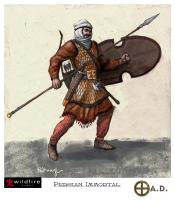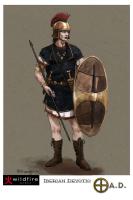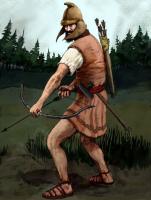
b.w.keough
-
Posts
483 -
Joined
-
Last visited
Posts posted by b.w.keough
-
-
how solid is the historical information about the Spartans? I had thought that most of the Roman and Greek histories were written well after the events they chronicled (i.e. writing down the oral history).
one of the things that keeps me interested in history is that what we know is limited to the surviving artifacts -- but these weren't patented serial-numbered assembly line pieces, they were hand-made and could be highly individual, never mind the fact the carbon-dating isn't specific to the exact day. I try my best to take Paul's historical unit descriptions and personalize/individualize them until he reins me in.
oh, and as an artist, some of you have heard me say that I like red. what's to say that the guy the who painted some fresco or pot didn't just feel like painting a red crest? or had extra red pigment? or wasn't paid by the grandson of a Spartan general to portray his grandfather in the military style currently in fashion to help a propaganda campaign? (don't forget that most of the military sculpture was politcally motivated and paid for by the winner of the day -- that's why many ancient scupltures are defaced [literally!])
not trying to jump on you, firepowa8, just playing a card for the other side of the agument.

-
so when will I get to see some charging camels?

-
glee! :-D
-
@dayyrush- the illustration you linked to was commission for "Warfare in the Classical World" by John Warry. In that book, the Immortal is described as having, "...a corslet of metal scales under his tunic." I can't say for certain, but I would assume Paal had me show it, because for our purposes, if you can't see it in the game, it isn't there. If it's decided it would be more accurate to hide it, that's a decision to be made when the texture artist goes to work. John Warry goes on to say, "His loose tunic is highly embroidered and could be crimson, blue, yellow, or even white."
Not every army had uniform colors, relying instead on standard-carriers to identify friend from foe. Many ancient warriors went to war with their regular clothes. I tend to gravitate towards red when I'm doing the higher-level guys because 1. it has strong graphic qualities and tickles my artistic nature 2. strong textile dyes were really expensive and most folks couldn't afford it. If you could afford deep reds, purples, yellows, you would use them to show off.
I did just watch the History Channel special on the Mughals and the reconstructed composite bows (which would have been nearly identical, never mind the 1500-2000 years in-between) and they were much more sharply curved than I showed here.
-
ah-ha! it is a rock, I was reading the shadow of the tree as a tree.

-
sweet!
what's the blue smudge in the tree, bottom center?
-
I'll let you in on a secret: I found a picture of a scrap of Persian cloth that was dated to 500 AD and built a repeating pattern out of that. then I used a bunch of multiply layers to arrange in the proper directions and hit those layers with some deform brushes. now, as long as no one tells Paul that this guy is wearing Cloth From the Future, we're cool!
the stripes on the pants are just stripes, tho.

-
-
Persian Amrtaka
From Paul's description: ".. the feared Persian elite troops known as the Immortals, or Amrtaka. These 10,000 men were of Persian or Median origin, serving as the Shah-an-Shah's personal guard in times of peace. In times of war they formed the most elite fighting force fielded by the Persian Empire. As a result their equipment and clothing was far better than the average Persian soldier."
-
just lots of practice...on this one I did most of the rendering in greyscale and then did the color on a multiply layer above it. PM/email me if you have more questions abou ti.
-
-
Iberian Devotio
From Paul's description: "Iberian Super Infantry - Known in modern Spanish as Devotio (Devoted), these men were professional soldiers, often serving as mercenaries in foreign armies. These men were renowned for their experience and skill. As a result they were well taken care of by their liege lords. They were often the best equipped of the Iberian troops, in this case being equipped with chainmail hauberks.
-
great looking work, the shadows are excellent!
-
excellent guys, congrats!
nomonkey -- I suppose it's more likely that you're going to work at one of the UK Firelfly offices instead of the one near me in Connecticut, huh?
-
hm, I noticed it last night, but it's not restricted to my home machine. the image above is not appearing here, but if I find my way to the forum thread I can see it there.
-
heh, yeah at typical RTS scale, pattern-welded = grey. unless we implement some super-godmode zoom tool....

thanks for the nice comments, folks. I have another one cooking, I hope the color turns out as well as this one.
-
a besides being gorgeous this screenie has a nice level of dramatic action, too!
one crit: the texture for the leather or cloth pointed caps of what I'm pretty sure are Pelasts looks a little flat and pink, imho. breaking up the color a little or adding a shadow at the bottom edge might help.
-
sweet! I'm diggin the celt with the mastiffs. >

-
yeah, the double post is not intentional, it's a work-around while a bug in the forum is fixed. You should have seen the mess I was making last night before Jason helped me.

-

Brennus is the name which the Roman historians give to the famous leader of the Gauls who took Rome in the time of Camillus. According to Geoffrey, the brothers invaded Gaul and sacked Rome in 390 B.C., "proving" that Britons had conquered Rome, the greatest civilization in the world, long before Rome conquered the Britons. We know from many ancient sources which predate Geoffrey that Rome was indeed sacked in 390 B.C., and that the raid was led by a man named Brennus, but he and his invading horde were Gallic, not British. In this episode several features of Geoffrey's editing method can be seen: he modified the historical Brennus, created the brother Belinus, borrowed the Gallic invasion, but omitted the parts where the Gauls seemed weak or foolish. His technique is both additive and subtractive. Like the tale of Trojan origin, the story of the sack of Rome is not pure fabrication; it is a creative rearrangement of the available facts, with details added as necessary. By virtue of their historical association, Beli and Bran are often muddled with the earlier brothers Belinus and Brennus (the sons of Porrex) who contended for power in northern Britain in around 390 BC, and were regarded as gods in old Celtic tradition.
-
ah yes, this time period was definitely pre-Schick. I wouldn't mind drawing some folks who were either clean-shaven or female, but so far, my assignments have all called for beards.
-
glad you like this one. I'm not sure when I'll be coloring this guy...lots of other units to get to.
I just replaced this image, the first file uploaded was older. I'm not sure anyone would notice but me, but I had corrected some of the arm anatomy.

-
-







Video Release
in Announcements / News
Posted
!! killer work guys, even better than I could have hoped :-D